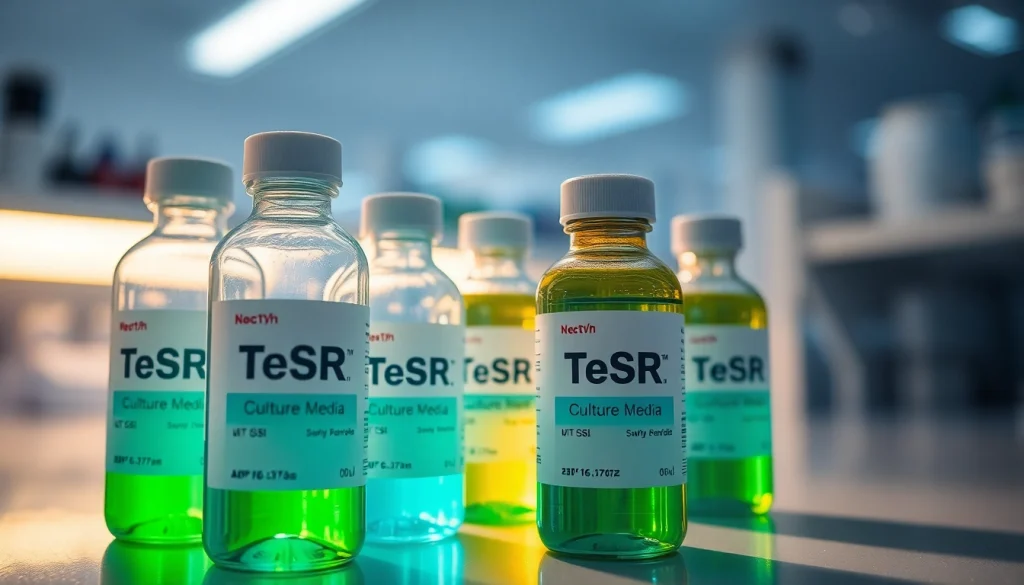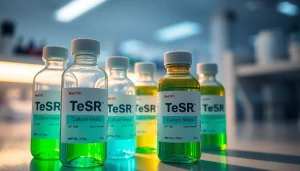
Understanding TeSR™ Feeder-Free Media
1. Overview of Pluripotent Stem Cells and Culture Media
Pluripotent stem cells (PSCs) are remarkable cells that possess the ability to differentiate into any cell type in the body, making them incredibly valuable for research and therapeutic applications. Their unique properties enable scientists to explore regenerative medicine, disease modeling, and drug discovery. A pivotal aspect of working with PSCs is the choice of culture media, which serves as the environment in which these cells are maintained and manipulated.
The TeSR™ family of feeder-free media, developed by STEMCELL Technologies, is designed to provide an optimal environment for the culture, maintenance, and differentiation of human embryonic stem (ES) and induced pluripotent stem (iPS) cells. These media have been rigorously formulated to support the unique requirements of stem cells, ensuring their viability and pluripotency.
2. Key Features of TeSR™ Media
TeSR™ media are notable for their carefully balanced components that ensure consistent cell behavior and high-quality culture conditions. Some of the defining features of TeSR™ media include:
- Feeder-Free Culturing: Unlike traditional methods that rely on feeder cells, TeSR™ media provide a fully defined, xeno-free environment.
- Enhanced Cell Viability: The formulations include essential growth factors and nutrients that promote sustained cell health.
- Batch-to-Batch Consistency: Each batch of TeSR™ media undergoes rigorous testing to ensure consistent performance across experiments.
- Compatibility with Differentiation: TeSR™ media support not only the maintenance of pluripotent states but also the differentiation into various cell lineages through subsequent formulations.
3. Applications in Research and Medicine
The versatility of TeSR™ media has led to widespread adoption in various fields of research, including regenerative medicine, cancer research, and drug screening. By utilizing TeSR™ products, researchers can:
- Generate and maintain high-quality human pluripotent stem cell lines for diverse applications.
- Efficiently differentiate stem cells into specialized cell types, such as cardiac, hematopoietic, and neuronal cells.
- Utilize cryopreservation media for safe long-term storage of stem cells, ensuring the preservation of their functional integrity.
Comparative Analysis of TeSR™ Media Products
1. mTeSR™ Plus vs. Other Maintenance Media
Among the assortment of media available, mTeSR™ Plus stands out due to its enhanced features. Developed from the mTeSR™1 formulation, it incorporates stabilized components that improve buffer capacity. Key advantages of mTeSR™ Plus include:
- Weekend-Free Cell Culture: With mTeSR™ Plus, researchers can maintain stem cell cultures over weekends without the need for media changes, reducing stress on cells.
- Improved pH Stability: The enhanced buffering agents help maintain a stable pH level, which is critical for preserving cell quality and function.
- cGMP Compliance: mTeSR™ Plus is manufactured under current Good Manufacturing Practices (cGMP), ensuring a high-quality product suitable for clinical applications.
2. Differentiation Media: TeSR™-E6 and TeSR™-E5
TeSR™-E5 and TeSR™-E6 are specifically designed for the differentiation of hPSCs into specific lineages.
- TeSR™-E5: This differentiation medium is optimized for epithelial lineage differentiation, providing a defined environment that supports the growth of epithelial cells.
- TeSR™-E6: Ideal for differentiating hPSCs into definitive endodermal cell types, TeSR™-E6 features a unique combination of growth factors that guide the commitment of hPSCs towards endoderm lineages.
3. The Role of Cryopreservation Media in Research
Cryopreservation is essential for the long-term storage of stem cells, ensuring that they can be thawed and used later without losing their pluripotent properties. TeSR™ offers several cryopreservation solutions, including:
- mFreSR™: Specifically formulated to maintain viability during cryopreservation, mFreSR™ is effective for both embryonic and induced pluripotent stem cells.
- FreSR™-S: A simplified cryopreservation medium designed for ease of use and compatibility with various cell types.
Optimization Techniques for hPSC Culture
1. Managing Medium Changes Effectively
Efficient management of culture medium is crucial for optimal stem cell growth. Recommended strategies include:
- Schedule regular medium changes based on cell density and growth patterns to maintain a healthy environment.
- Utilize mTeSR™ Plus for its longer media change intervals, allowing researchers to minimize cell handling.
2. Importance of Cytokines in Culture
Cytokines play a vital role in supporting the culture of hPSCs. They regulate various functions including proliferation, differentiation, and survival. TeSR™ media formulations include essential cytokines that:
- Enhance cell signaling pathways critical for maintaining pluripotency.
- Facilitate the transition from pluripotent states to specific differentiated lineages.
Understanding the specific functions of cytokines within each media can aid researchers in tailoring their approaches to maximize efficacy.
3. Assessing Culture Integrity and Quality
To ensure reliable results, maintaining the integrity and quality of hPSC cultures is paramount. Best practices include:
- Regular monitoring of cell morphology, growth rates, and cell viability using trypan blue exclusion or live/dead assays.
- Periodic genomic analysis to ensure genetic stability and prevent drift.
Challenges and Solutions in Stem Cell Culture
1. Variation in Research Outcomes
Inconsistencies in stem cell culture can lead to variable research outcomes. Strategies to mitigate these challenges include:
- Implementing standardized protocols across laboratories to enhance reproducibility.
- Culturing hPSCs under tightly controlled conditions to minimize external variability.
2. Safety and Quality Control Measures
Ensuring the safety and quality of stem cell cultures is crucial, particularly in the context of clinical applications. Recommended practices include:
- Regular quality control checks of media components to prevent contamination and variability.
- Utilizing only cGMP-compliant products, like those from the TeSR™ line, to enhance safety.
3. Case Studies and Success Stories
Successful applications of hPSCs have been documented across various studies. For example, research utilizing mTeSR™ media has resulted in breakthroughs in:
- The generation of patient-specific cardiomyocytes for drug testing.
- Development of new therapies for degenerative diseases, demonstrating the translational potential of stem cell research.
Future Directions in hPSC Research
1. Trends in Feeder-Free Culture Practices
The shift toward feeder-free culture systems is gaining momentum. This trend is driven by:
- The increasing demand for standardized and reproducible stem cell lines for clinical and research applications.
- Advancements in media formulations that accommodate the complex needs of hPSCs.
2. Advances in Differentiation and Reprogramming Techniques
Recent innovations in differentiation protocols are expanding the range of cell types that can be derived from hPSCs. These advancements include:
- Improved methodologies for generating tissue-specific progenitors from hPSCs.
- Increased efficiency in reprogramming somatic cells into pluripotent states using specialized media like ReproTeSR™.
3. Impact on Regenerative Medicine and Therapies
The continued evolution of hPSC culture and differentiation techniques holds immense promise for regenerative medicine. The potential applications include:
- Development of personalized medicine approaches that leverage patient-derived stem cells.
- Creation of bioengineered tissues for transplantation and disease modeling, aiding in the development of new therapies.
The results of these efforts could fundamentally change how we approach treatment and management of diseases.






